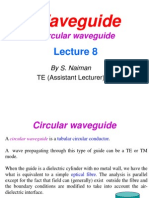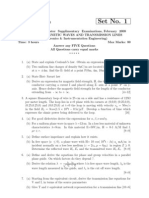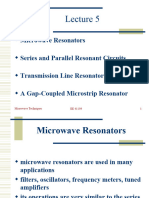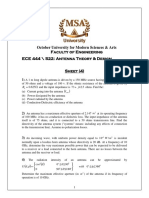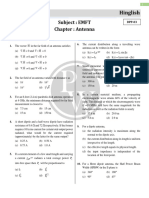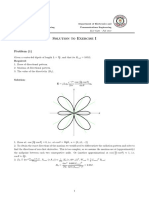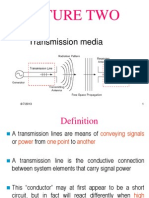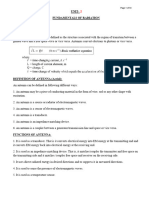Assignment 3
Uploaded by
Phani SingamaneniCopyright:
Available Formats
Assignment 3
Uploaded by
Phani SingamaneniOriginal Description:
Copyright
Available Formats
Share this document
Did you find this document useful?
Is this content inappropriate?
Copyright:
Available Formats
Assignment 3
Uploaded by
Phani SingamaneniCopyright:
Available Formats
Assignment-3
1) A transmitter transmits an AM signal with a carrier frequency of 1500 kHz. When an inexpensive radio receiver
(which has a poor selectivity in its RF-stage bandpass filter) is tuned to 1500 kHz, the signal is heard loud and clear.
This same signal is also heard (not as strong) at another dial setting. State, with reasons, at what frequency you will
hear this station. The IF frequency is 455 kHz.
2) Consider a superheterodyne receiver designed to receive the frequency band of 1 to 30 MHz with IF frequency
8 MHz. What is the range of frequencies generated by the local oscillator for this receiver? An incoming signal with
carrier frequency 10 MHz is received at the 10 MHz setting. At this setting of the receiver we also get interference
from a signal with some other carrier frequency if the receiver RF stage bandpass filter has poor selectivity. What is
the carrier frequency of the interfering signal?
3) Figure 1 shows the block diagram of a heterodyne spectrum analyzer. It consists of a variable-frequency oscillator,
multiplier, band-pass filter, and root mean square (RMS) meter. The oscillator has an amplitude A and operates over
the range f0 to f0 + W, where f0 is the mid-band frequency of the filter and W is the signal bandwidth. Assume that
f0 = 2W, the filter bandwidth f is small compared with f0 and that the pass-band magnitude response of the filter is
one. Determine the value of the RMS meter output for a low-pass input signal g(t).
Fig. 1
4) In this problem we study the idea of mixing in a superheterodyne receiver. To be specific, consider the block
diagram of the mixer shown in Figure 2 that consists of a product modulator with a local oscillator of variable
frequency ft, followed by a band-pass filter. The input signal is an AM wave of bandwidth 10 kHz and carrier frequency
that may lie anywhere in the range of 0.535 to 1.605 MHz; these parameters are typical of AM radio broadcasting. It
is required to translate this signal to a frequency band centered at a fixed intermediate frequency (IF) of 0.455 MHz.
Find the range of tuning that must be provided M the local oscillator to achieve this requirement.
Fig. 2
5) Using small-error analysis of PLL, show that a first-order loop [H(s) = 1] cannot track an incoming signal whose
instantaneous frequency is varying linearly with time [i(t)= kt2]. This signal can be tracked within a constant phase
if H(s) = (s + a)/s. It can be tracked with a zero phase error if H(s) = (s2 + as + b) /s2.
You might also like
- Lab Manual OF Antenna and Wave Propagation: Using MATLABNo ratings yetLab Manual OF Antenna and Wave Propagation: Using MATLAB83 pages
- 3 Amplitude Modulation Fundamentals Part 1No ratings yet3 Amplitude Modulation Fundamentals Part 128 pages
- Em Waves and Transmission Lines May 2017No ratings yetEm Waves and Transmission Lines May 20175 pages
- r050211001 Electromagnetic Waves and Transmission LinesNo ratings yetr050211001 Electromagnetic Waves and Transmission Lines8 pages
- Em Waves and Transmission Lines - June-2015No ratings yetEm Waves and Transmission Lines - June-20154 pages
- AP UNIT 3 The Electric Dipoles and Thin Linear Antennas PDFNo ratings yetAP UNIT 3 The Electric Dipoles and Thin Linear Antennas PDF21 pages
- EE 426 HW2 Due:: HW Problems: 1-5 Supplementary Problems: 6,7No ratings yetEE 426 HW2 Due:: HW Problems: 1-5 Supplementary Problems: 6,72 pages
- 7-8 Directivity of Circular Loop Antennas With Uniform CurrentNo ratings yet7-8 Directivity of Circular Loop Antennas With Uniform Current170 pages
- Unit 3 Antenna Fundamentals and Wire AntennasNo ratings yetUnit 3 Antenna Fundamentals and Wire Antennas256 pages
- Radiation From An Oscillating Electric Dipole100% (2)Radiation From An Oscillating Electric Dipole15 pages
- 7A4EC10 ELECTROMAGNETICWAVESANDTRANSMISSIONLINESfrNo ratings yet7A4EC10 ELECTROMAGNETICWAVESANDTRANSMISSIONLINESfr6 pages
- 07a31001 Electromagnetic Waves and Transmission Lines100% (1)07a31001 Electromagnetic Waves and Transmission Lines6 pages
- Escuela Superior Politécnica De Chimborazo: D= P P U sin (θ) dθ d ∅ PNo ratings yetEscuela Superior Politécnica De Chimborazo: D= P P U sin (θ) dθ d ∅ P7 pages
- Unit 2 - Fundamental of Radiation (Notes + Problems)No ratings yetUnit 2 - Fundamental of Radiation (Notes + Problems)54 pages
- Optical and Microwave Technologies for Telecommunication NetworksFrom EverandOptical and Microwave Technologies for Telecommunication NetworksNo ratings yet
- Simulation and Animation: Inverse Kinematics (Part 2)No ratings yetSimulation and Animation: Inverse Kinematics (Part 2)46 pages


